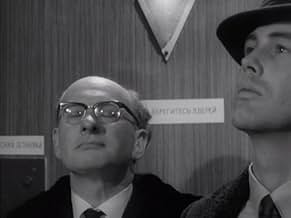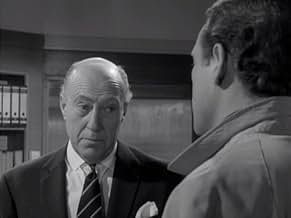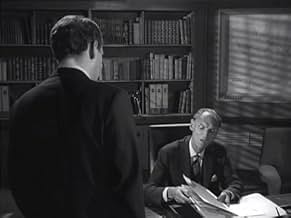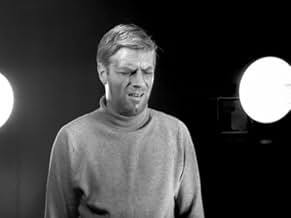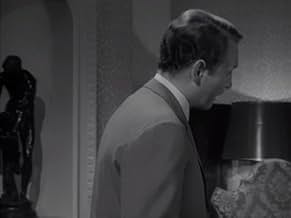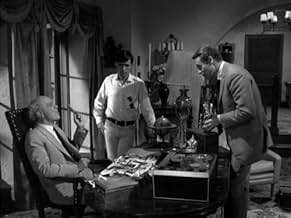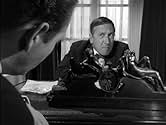IMDb RATING
8.2/10
1.7K
YOUR RATING
John Drake is a special operative for M9, specializing in security assignments against any subversive element that threatens world peace.John Drake is a special operative for M9, specializing in security assignments against any subversive element that threatens world peace.John Drake is a special operative for M9, specializing in security assignments against any subversive element that threatens world peace.
Browse episodes
Featured reviews
in my opinion the greatest ever spy series on TV. the original half hour series were amazing and you got a start, middle and end, John Drake always delivers. fast forward 3/4 years and Mr. Drake is back in 1 hour episodes and looking at these you will find an a to z of character actors involved in some fantastic stories. Drake is a loner who will not let himself get involved with anyone romantically due to the nature of his job, in fact he is the ultimate gentleman spy and he has to get close to people to solve the case. look at the episode with Bernard Bresslaw drake really does to get to like him and vice versa the pay off leaves Bernard a very sad man. all in all a fantastic slice of British TV and history, forget Bond, Drake is the man
Believe it or not, I did not see any of this programme until 1992-93. It was shown one per night on CBC-Windsor at difficult to establish late hours. In spite of the inconvenience, I made it my business to see as many as possible; my first was when Drake had a car crash, blacking out . . . and you will just have to see it.
It was well cast with well-crafted supporting characters. I had no idea it was the progeny of an earlier show about a NATO operative, a few episodes of which I saw in 1961 (and none since). One notes comment that SECRET AGENT was inspired by the 007 films, which is beyond dispute, but I respectfully disagree that it was as "gadgety" as the Bond films, and furthermore it was devoid of the latent camp. Exception: "Would You Like Some Wine" (if memory serves). Perhaps it was the b.&w. presentation that made it more -- pardon the cliche -- gritty.
Most of the episodes were good. It seems some of the later ones (did the series run into 1967?) were the weakest: Far-fetched and in a few cases ridiculous without being tongue-in-cheek. I cannot say whether SECRET AGENT came to an end because it ran out of petrol or because the more ambitious THE PRISONER was on the drawing boards. All said, I agree that one should make every attempt to see the series, and no, being period piece does not distract for those able to make a mature adjustment to such.
It was well cast with well-crafted supporting characters. I had no idea it was the progeny of an earlier show about a NATO operative, a few episodes of which I saw in 1961 (and none since). One notes comment that SECRET AGENT was inspired by the 007 films, which is beyond dispute, but I respectfully disagree that it was as "gadgety" as the Bond films, and furthermore it was devoid of the latent camp. Exception: "Would You Like Some Wine" (if memory serves). Perhaps it was the b.&w. presentation that made it more -- pardon the cliche -- gritty.
Most of the episodes were good. It seems some of the later ones (did the series run into 1967?) were the weakest: Far-fetched and in a few cases ridiculous without being tongue-in-cheek. I cannot say whether SECRET AGENT came to an end because it ran out of petrol or because the more ambitious THE PRISONER was on the drawing boards. All said, I agree that one should make every attempt to see the series, and no, being period piece does not distract for those able to make a mature adjustment to such.
Taken as a whole, "Danger Man" is one of the finest Television series of its era. Patrick McGoohan did an excellent job portraying British Intelligence Agent John Drake, providing a frankly refreshing alternative to the James Bond type character of the Spy genre.
Danger Man consisted of 4 seasons done in a somewhat unusual manner. In the first season, televised 1960-1961, John Drake is a NATO intelligence officer working for the UN in New York. There were 39 half-hour episodes filmed in black and white. The series was cancelled after this first season and it was not until 1964 that it was reprised (because of the "spy craze" of that time) for its second season. John Drake no longer works for NATO but rather for the British Government intelligence agency "M9". The shows are also now 1 hour episodes, and for seasons 2 & 3 (combined total 45 episodes) are filmed in black and white. The fourth season consists of only 2 1-hour episodes that are filmed in color (or is it "Colour" :-)?
The character of John Drake is one of a spy with morals. He doesn't use women, rarely carries a gun much less uses one, and prefers to think his way through his missions. He is no weakling however ( McGoohan is 6' 2.5") and knows how to handle himself very well in hand-to-hand fighting. He is adept at several languages and reasonably good at disguises. The gadgetry is more sparse and more believable than that found in the Bond films, with the most common spy accessories being a camera hidden in a cigarette lighter, and an electric razor that doubles as a tape recorder. He is sometimes at odds with his superiors when they request him to do things that he considers immoral or dishonorable and pays the price for doing what he sees as right.
When aired in the US, a different opening sequence and song was added. Originally the series title of "Danger Man" was going to be retained but at the last moment it was deemed that "Secret Agent" would catch a bigger share of the US audience. The famous "Secret Agent" song sung by Johnny Rivers had its refrain originally phrased for "Danger Man" but then had to be changed to "Secret Agent MAN" to work.
As of this writing, A&E Home Video has brought to DVD region 1 (USA/Canada) the first 38 episodes of Seasons 2&3. It is hoped they will pubish the remaining 7 Season 3 episodes and the 2 Season 4 episodes, and it is the personal hope of this author that the will then consider to publish the original 39 half hour episodes of Season 1.
Patrick McGoohan stopped doing Danger Man because he thought the stories had run their course and because he wanted to do his own unique project, which became the legendary series "The Prisoner". There has been ongoing rumor that a Prisoner Movie is in the make, with McGoohan having the hand at writing the script, and possibly directing and staring in a cameo role. To Patrick, your fans hope in relation to this project, that one more time we can all "Be seeing you".
Danger Man consisted of 4 seasons done in a somewhat unusual manner. In the first season, televised 1960-1961, John Drake is a NATO intelligence officer working for the UN in New York. There were 39 half-hour episodes filmed in black and white. The series was cancelled after this first season and it was not until 1964 that it was reprised (because of the "spy craze" of that time) for its second season. John Drake no longer works for NATO but rather for the British Government intelligence agency "M9". The shows are also now 1 hour episodes, and for seasons 2 & 3 (combined total 45 episodes) are filmed in black and white. The fourth season consists of only 2 1-hour episodes that are filmed in color (or is it "Colour" :-)?
The character of John Drake is one of a spy with morals. He doesn't use women, rarely carries a gun much less uses one, and prefers to think his way through his missions. He is no weakling however ( McGoohan is 6' 2.5") and knows how to handle himself very well in hand-to-hand fighting. He is adept at several languages and reasonably good at disguises. The gadgetry is more sparse and more believable than that found in the Bond films, with the most common spy accessories being a camera hidden in a cigarette lighter, and an electric razor that doubles as a tape recorder. He is sometimes at odds with his superiors when they request him to do things that he considers immoral or dishonorable and pays the price for doing what he sees as right.
When aired in the US, a different opening sequence and song was added. Originally the series title of "Danger Man" was going to be retained but at the last moment it was deemed that "Secret Agent" would catch a bigger share of the US audience. The famous "Secret Agent" song sung by Johnny Rivers had its refrain originally phrased for "Danger Man" but then had to be changed to "Secret Agent MAN" to work.
As of this writing, A&E Home Video has brought to DVD region 1 (USA/Canada) the first 38 episodes of Seasons 2&3. It is hoped they will pubish the remaining 7 Season 3 episodes and the 2 Season 4 episodes, and it is the personal hope of this author that the will then consider to publish the original 39 half hour episodes of Season 1.
Patrick McGoohan stopped doing Danger Man because he thought the stories had run their course and because he wanted to do his own unique project, which became the legendary series "The Prisoner". There has been ongoing rumor that a Prisoner Movie is in the make, with McGoohan having the hand at writing the script, and possibly directing and staring in a cameo role. To Patrick, your fans hope in relation to this project, that one more time we can all "Be seeing you".
For forty years, cult T.V. fans have been asking the question: "Who was Number Six?", referring, of course, to Patrick McGoohan's fantasy masterpiece 'The Prisoner'. But in an earlier series, he played a character who was equally mysterious and enigmatic. The show was 'Danger Man' and the character was 'John Drake'.
Throughout the series, we see little of Drake himself. We know he lives in London, at a fashionable mews address, drives a Mini Cooper, is fond of cigars and doesn't seem all that fond of women. Whenever one throws herself at him, such as the Jill Melford character in 'The Galloping Major', he keeps her at arms length. This self-imposed chastity endeared him to us kids, as it meant that the stories could not get bogged down in soppy romantic sub-plots. Like Bond, Drake loves gadgets - the 'From Russia With Love' variety - radios in electric razors, microphones concealed in walking sticks, typewriters containing cameras and so on. Occasionally, Drake is called upon to impersonate an army major, butler, or schoolteacher, which meant his entire personality would go submerged. In this respect, 'Danger Man' was the forerunner to the U.S. series 'Mission:Impossible', which also featured agents about whom the viewer knew next to nothing other than their names.
The series was grounded in reality, unlike the later 'Avengers' and 'U.N.C.L.E.'. Each week, Drake would be assigned to rescue a captured British agent, locate stolen defence plans, or penetrate an enemy spy ring. McGoohan played 'Drake' in a terse, arrogant yet oddly charismatic way, preempting Sean Connery's early performances as 'James Bond'.
'Danger Man' was produced in two batches - one transmitted in Britain in 1959/60, and another from 1964-67. Its the early half-hour episodes which work best for me, being more tightly written and directed. In these, Drake works for N.A.T.O., and appears to be an American, but later on, he would be redefined as an Englishman attached to the British Secret Service outfit M9. Of the hour-long episodes, I cite 'Colony Three' ( the inspiration for 'The Prisoner' ), 'No Marks For Servility', 'Not So Jolly Roger' and 'Whatever Happened To George Foster?' as amongst my personal favourites.
'Danger Man' ended with a rousing two-part colour adventure set in Japan - 'Koroshi' and 'Shinda Shima'. Though not popular with many fans, for my money they rounded off the series nicely, and made one wish McGoohan had done more in similar vein before moving onto 'The Prisoner'.
'Danger Man' does not get repeated often because it was mostly made in black and white. Yet, for anyone who loves '60's action television, it is essential viewing.
Throughout the series, we see little of Drake himself. We know he lives in London, at a fashionable mews address, drives a Mini Cooper, is fond of cigars and doesn't seem all that fond of women. Whenever one throws herself at him, such as the Jill Melford character in 'The Galloping Major', he keeps her at arms length. This self-imposed chastity endeared him to us kids, as it meant that the stories could not get bogged down in soppy romantic sub-plots. Like Bond, Drake loves gadgets - the 'From Russia With Love' variety - radios in electric razors, microphones concealed in walking sticks, typewriters containing cameras and so on. Occasionally, Drake is called upon to impersonate an army major, butler, or schoolteacher, which meant his entire personality would go submerged. In this respect, 'Danger Man' was the forerunner to the U.S. series 'Mission:Impossible', which also featured agents about whom the viewer knew next to nothing other than their names.
The series was grounded in reality, unlike the later 'Avengers' and 'U.N.C.L.E.'. Each week, Drake would be assigned to rescue a captured British agent, locate stolen defence plans, or penetrate an enemy spy ring. McGoohan played 'Drake' in a terse, arrogant yet oddly charismatic way, preempting Sean Connery's early performances as 'James Bond'.
'Danger Man' was produced in two batches - one transmitted in Britain in 1959/60, and another from 1964-67. Its the early half-hour episodes which work best for me, being more tightly written and directed. In these, Drake works for N.A.T.O., and appears to be an American, but later on, he would be redefined as an Englishman attached to the British Secret Service outfit M9. Of the hour-long episodes, I cite 'Colony Three' ( the inspiration for 'The Prisoner' ), 'No Marks For Servility', 'Not So Jolly Roger' and 'Whatever Happened To George Foster?' as amongst my personal favourites.
'Danger Man' ended with a rousing two-part colour adventure set in Japan - 'Koroshi' and 'Shinda Shima'. Though not popular with many fans, for my money they rounded off the series nicely, and made one wish McGoohan had done more in similar vein before moving onto 'The Prisoner'.
'Danger Man' does not get repeated often because it was mostly made in black and white. Yet, for anyone who loves '60's action television, it is essential viewing.
I agree 100% with the previous comments. A nice departure for this series was that the hero wasn't forever slobbering over women - in fact Drake remained impervious to their charms - a sort of 1960s Sherlock Holmes - without an Irene Adler!. Only 2 episodes were made in colour, and these were to form part of the 1967 series, but after the two episodes were filmed PMcG wanted to drop the series and make 'The Prisoner' which is another story. It is probably because they are in black and white that domestic UK TV has not rebroadcast these stories, but the UK satellite channel Granada Plus has the rights to the ITC catalogue, which made Danger Man, but they seem reluctant to repeat B/W adventure series, though they do repeat B/W comedy shows like the earlier series of 'On The Buses' and 'Nearest and Dearest' etc. Perhaps if enough people contacted them they might think again?.
At least one videotape is available commercially of Danger Man, I have seen it recently in a store in London, as there are 4 episodes on one tape I assume that these are from the 1960 series, when the stories ran for 30 minutes. In the early days of Channel 4 (1982) they rebroadcast all 39 episodes of the original series twice a week.
At least one videotape is available commercially of Danger Man, I have seen it recently in a store in London, as there are 4 episodes on one tape I assume that these are from the 1960 series, when the stories ran for 30 minutes. In the early days of Channel 4 (1982) they rebroadcast all 39 episodes of the original series twice a week.
Did you know
- TriviaAfter two seasons of black-and-white episodes, it was decided to switch to colour production. But after only two episodes were completed, McGoohan quit the series to devote his energies to Le prisonnier (1967). These two episodes of the third season, Koroshi (1967) and Shinda Shima (1967) were edited together to form the movie Koroshi (1968).
- Crazy creditsThe first episode broadcast in the United States ("Battle of the Cameras") actually features two opening credit sequences. The first is a brief, 10-second introduction featuring a few bars of "Secret Agent Man" and a credit for Patrick McGoohan (running roughly the same length as the original UK credits). This is followed by the teaser, and then the regular credits. In all future US broadcasts, the pre-teaser credit sequence was dropped.
- Alternate versionsTwo color episodes were produced as part of a season that was interrupted when McGoohan quit the series to make "The Prisoner." These two episodes were edited together to form the movie Koroshi (1968). The original unedited episodes were released on video in the UK in the 1980s.
- ConnectionsEdited into Koroshi (1968)
- How many seasons does Secret Agent have?Powered by Alexa
Details
- Release date
- Country of origin
- Official site
- Language
- Also known as
- Secret Agent
- Filming locations
- Production company
- See more company credits at IMDbPro
- Runtime49 minutes
- Aspect ratio
- 1.33 : 1
Contribute to this page
Suggest an edit or add missing content


